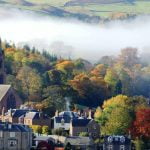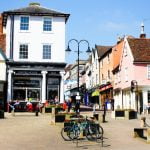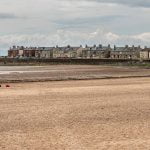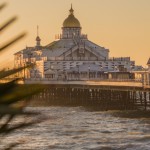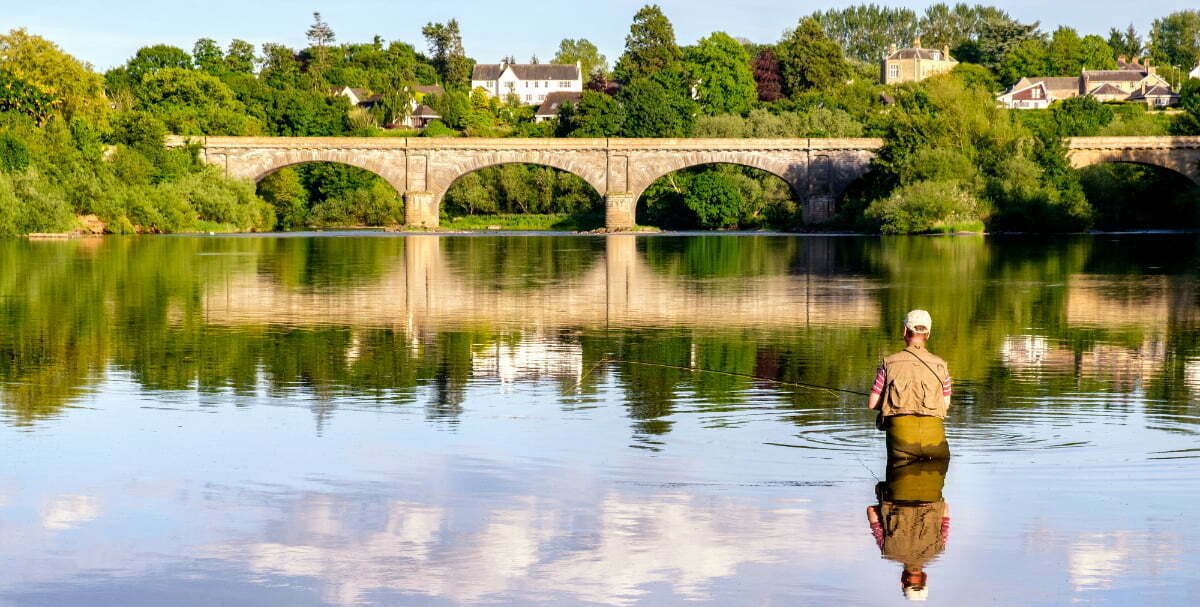
The Roxburghshire gem of the Scottish Borders.
Kelso was once the largest, most important Abbey town in Scotland. Hard to believe, given that the modern town has a population of roughly 7,000 people. Kelso Abbey, which made the town famous, opened in 1128, some 70 years after the Normans landed on the east coast and decided to find their home here. It is on the heel of Scotland, and its very name means the heel of the land.
We wanted to find out all about the rich history of this not-so-rich town. Why did Kelso fall from glory? How long has this stretch of land been occupied? Most importantly, if I take my motorhome there, will I be welcome or hunted out of town with a mob waving brooms in the air and calling Shenanigans? Let’s find out.
The Early Days of Kelso
Long ago and far away, the town’s name was Chalkheugh. Over the years, this has shortened down to Kelso. Kelso lies within Clan Kerr’s lands, but other prominent clans in the area include Clans Douglas, Pringle, Scott, and Elliot. Kelso lives at the juncture of the river’s Tweed and Teviot.
Clan Pringle has a tower nearby, so we will do a short delve into their history. We cover the Kerr family later. King Alexander III’s records mention the Pringle clan in the mid-13th century. Pringle comes from Hoppringle and is mentioned in 1296 when Elias De Hoppringle, a Norman, added his seal to the Ragman Roll. The last clan chief died in 1737, with the historic seat of Hoppringle Castle razed to the ground. The mansion that laterally housed the remaining clan members was destroyed by fire in 1992. There are plenty of Pringles in Scotland to this day. They were a prominent southern clan.
The history books mention the town before the clan Kerr inherited the titles there. The first written mention is in church records when King David I of Scotland gifted the ‘church at Calchou’ to the monks from Tiron in France. Scotland and France had a long history as allies in the old days. In fact, it is known as the ‘Auld Alliance’.
The Scots and the French had an on-again, off-again relationship with their mutual neighbour. The two countries signed a pact in 1295/6 that was never forgotten. In 1419 and again in 1424, an estimated 15,000 Scots left to fight for France. Legend says that a Scots merchant still got his first choice on the best Bordeaux as late as 1707.
Kelso was a small town connected to its other half, Wester Kelso, by a wooden bridge. Wester Kelso held a castle and a seemingly thriving market town. The town housed the servants to the Roxburghe estates and the town and abbey town were synonymous with one another. At some point in the middle ages, the two towns were split from one another. Although it was originally believed that the two towns absorbed into one, more recent evidence suggests otherwise.
Kelso Abbey and the Town’s Growth
In those days, people would flock to areas they felt safe and build towns there. When the Abbey formed around the church, it needed staff and a market to trade in. Abbeys were good news for towns since they brought pilgrims. Monks even built piped water supplies or taught locals how to farm. Originally, the town formed two burghs. Wester Kelso and Kelso. Wester Kelso lay across the river and the two shared a bridge. Between the growth propelled by the pilgrims and the abbey, and later the arrival of the Dukes of Roxburgh, the town eventually became one.
The monks from Tiron originally settled in the Selkirk area, until King David gave them a home. The gift was paid off in abundance as the monks attracted wealth and several large noble families to the area. Over the years, several noble families built houses in the surrounding areas. The Royal Burgh of Roxburgh was just across the river from the Duke’s castle. The Abbey and the Castle became a dual pilgrimage. The town flourished until the Roxburgh seat was destroyed. In 1545, the town was further decimated when part of the Abbey was destroyed by English invaders.
The Eight Years War (the Rough Wooing)
The border town of Kelso was on the warpath during the 8 Years’ War, also called the Rough Wooing. Sir Walter Scott visited Kelso over the years because he had family members in the area. He described the war as a romantic triste and the phrase stuck. The war lasted from 1543-1551 and included Kelso in the firing line. The King of England was trying to force his infant child into a marriage with Mary Queen of Scots. Kelso suffered as the Abbey declined, then again as it closed. The oldest house in town today other than the castle is Turret House, c.1694.
This was a period of great religious turmoil in Scotland. There were long periods where Catholics and Protestants hunted each other, with Catholicism associated with allegiance to Rome. Mary Queen of Scots would later add to this by being a catholic, even when her cousin Elizabeth was a protestant. The Queen was urged to hide her Catholicism from the noble men of Scotland, who already believed her incapable of her role. Mary was forced to marry young and quickly, into arrangements that appeased the nobility. This ultimately led to her death as much as the betrayal by her cousin did.
The Middle Ages in Roxburghshire
At the end of the 16th century, the Reformation saw the Abbey’s close down. The church’s influence declined and the lands that belonged to the abbey went to the Kerr family. Clan Kerr are one of the prominent Reiver clans of the Scottish Borders. Reiver clans were those that performed raids into English territory to steal cattle and gold. The Reivers roved between the 13th and 17th centuries, but the clan origins lie with the Normans.
Many of the Normans came over with the invaders in 1066 and afterwards. Some settled the lands and took the names of the lands and others named themselves after the leader. The first recorded Ker in Scotland is Johanes Ker, c.1190. The clan motto is Sero Sed Serio… Late, but in earnest.
The Dukes of Roxburgh built Floor Castle in 1721 and started the rapid expansion of the town. In 1715 and 1745, the Jacobite army passed through Kelso. Charles Stewart’s horse cast a shoe on the way back. There is still a marker in town that commemorates the occasion. Bonnie Prince Charlie planted white rosebushes in the town, or so the tale goes on. They say you can still see them in neighbour’s gardens at the right time of year.
Fun Facts and Trivia About Kelso in the Scottish Borders
At this point in the tour, we stop for a breather and seek out some fun trivia about Kelso for you to snigger at. Some are fun, some are morbid, but all are as true as we can make them. Here’s what you need to know about Kelso:
- Kelso might be inland but the River Tweed has a historic link to Salmon Fishing. To this day, there are harsh punishments in place if you disturb the fish mating grounds upriver. Fishing was a popular profession here.
- They say that Kelso has the largest market square in Scotland. This is a throwback to the days when the monks made it one of the wealthiest regions in the Borders.
- The vast and flourishing Royal Burgh of Roxburgh which lay on the opposite bank of the Tweed has now vanished. It’s just gone. The titles still exist, and the Dukes are still there, and there’s even a Roxburghshire. There just isn’t a thriving town anymore. The town’s situation across the bridge saved it from a similar fate. And the Kerrs. The Kerrs were ferocious.
- Kelso Parish once levied taxes of 2 pennies on every pint of ale sold in the town. Years later, when the wooden bridge had been destroyed by floods, the same charges replaced it.
The Industrial Period for the Southern Scots
The permanent bridge at Kelso dates to the Industrial Era. The stone bridge opened in 1754 but the modern version dates to 1803. Architect John Rennie, who later designed London Bridge, was behind its construction.
The town had previously survived on fishing and local farming but during the industrial era, it became known for leatherworking. The fine leather goods produced her drew in country nobles. The shoemaking industry took off. Added to the natural beauty of the surrounding countryside, the area became popular with the gentry. Kelso built a corn mill but didn’t fall victim to the textile mills popular in the area at the time.
The local Ednam House dates to the 1760s and the octagonal parish church opened in 1783. In 1788, a letter records the unearthing of bones and a gold coin with Richard II’s picture on it in the St James’ Green. The Town House in the town centre opened in 1816. In 1822, the National Hunt horse racing track opened here. They say it is Britain’s friendliest racetrack. This attracted the nobility in larger numbers until Kelso gained a reputation for being a bit posh. During this period, the town experienced a second surge of prosperity. The high school and two primary schools opened. There has been a grammar school in Kelso since before 1783 because that’s when Sir Walter Scott went to school here.
Modern Day Kelso
The Town Hall got a facelift in 1908. In 1922, the town’s contribution to the war effort was commemorated in two plaques.
Since the 1960s, tourism has been a popular industry in Kelso. The town is quaint and colourful, with townhouses erected by nobility still found on every street. The local manor and country residences are stunning and some of them give tours. The fishing industry has ever been popular here, with tourists coming here for the salmon every year. Be sure to get the correct Salmon Fishing License if you intend to do it.
In the 1980s, archaeologists working in the west of town realised Wester Kelso was farther west than anyone previously thought. This would mean that Wester Kelso did not survive and the Kelso we know today is the eastern end of the town.
The best time to visit Kelso is in the first week of September. Every year, they hold an annual fair that lasts a full week. During that week, a Kelso Laddie is chosen with a right hand and left hand man, to travel around the local settlements and invite everyone to a big party at the end of the week. It’s a huge festival that can attract 10,000 people or more.
Kelso is a gorgeous Borders town that attracts thousands of tourists every year. When you reach this stretch of the country, you realise what it is that draws so many immigrants into Scotland, every year. From the hills to the rivers to the stillness of the lochs, Kelso inspires awe. It’s the ideal place for a staycation. Just don’t upset the Kerrs.
Famous People from Kelso
At this junction, we like to intervene with a few famous faces. Who came from Kelso in Scotland and which famous people might I meet there? Here are the historical and the modern famous people from Kelso:
- VC recipient Donald Farmer lived here
- Writer and poet Thomas Pringle lived here
- James Ballantyne, Sir Walter Scott’s Printer, was a Kelso man
- Jennie Kidd Trout, who emigrated to Canada and became Canada’s first licensed female medical doctor. Well done, Jennie.
- Sir William Purves, the first Chief of HSBC, was from here.
OK, so you’re not meeting any of them in Sainsbury’s. Never mind. The attractions should cheer you up.
Best Attractions in Kelso
If you are stopping here for any length of time, you will want to know what to see and do here. This is the best list of Kelso attractions you will find on the internet, simply because it is told by a Scot.
Historic Sites and Landmarks
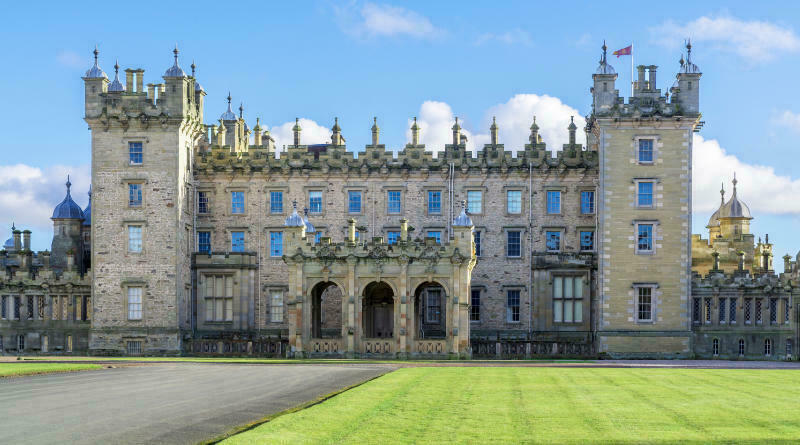
Image: dvlcom/shutterstock.com
Don’t miss the historic Floors Castle. This architectural marvel was home to the Dukes of Roxburgh, the royal burgh. It’s no less than a palace today, as countless descendants added to it over the years. Built in 1721, the castle features Victorian glasshouses, a Millennium Garden, a cycle trail, and a woodland walk. The castle is stunning and houses its own cafes. There is even a restaurant so you could spend the whole day here.
Another attraction that formed a landmark in the area, you should see Kelso Abbey while you are passing through. Kelso Abbey survived until the Reformation in 1559. From the 1600s onwards, artists flocked to the area to paint it. It is now the property of Historic Environment Scotland which perform the maintenance and restoration work. That it still stands from the 1100s is incredible.
The oldest house in the town is Turret House and it is a bed and breakfast now. The house belonged to John Palmer, Boatman of Kelso. It has a distinctive turret feature on the side with a tower at the top. It’s unique and worth a photo or two.
Galleries and Museums
There are not many museums inside the town of Kelso, which has dwindled in reputation over recent years. However, one location stands out even among the rest of the county. You can visit the River Tweed Salmon Fishing Museum in Kelso. Learn about the history of the River and of fishing in the Scottish Borders. The museum explores the romanticised aspects of salmon fishing, exploring some of the stories from the river. There are over 2,000 artefacts to view here.
If you want more museums, head north to the mouth of the River Tweed, and visit the Coldstream Museum. This museum details all of the wars fought in the local lands – the Borders – and there have been many, many wars. Learn about Flodden, about defending the Tweed, and about the Reiver clans. The museum is in the market square in Coldstream to the north.
You can choose between the Wee Gallery in Kelso, or visit Eptas Arts for fine art. The only fine art in the museum is of the fishing. You might find other local makers on display at the local gift shops. You can also visit the nearby Kinsman-Blake Gallery to see the working studios where the pottery is made.
Outdoor Attractions
Kelso is famous for friendly horse racing, so there’s no reason not to spend a day at the races while you are here. Put on your best had and coat and head out to the track throughout Jump Season – from September to May. Watch a race in summer, have some prosecco, and get a sunburn. It’s a fun day out exploring an activity you don’t do much at home.
You can go out and visit St James’s Green in Roxburgh. The area lies between the castle and the town. It is nice to walk your dogs in, enjoy some sunbathing on, or play some outdoor games. Remember, this is where they found old bones and coins of Richard II back in the late 1700s… If only we had a metal detector…
You can visit a lovely remnant of medieval architecture out at Smailholm Tower. Run by Historic Environment Scotland, the tower has ties to Sir Walter Scott. The tower is perched on a rocky outcrop with a view for miles. This tower was built by Clan Pringle, which shows you how prominent they were in this area. The tower is open to the public and holds costumed figures and rich tapestries. Legend has it that the sight of the tower, balanced against a backdrop of scenic hills and rolling valleys, inspired his imagination as a young boy.
Sports and Recreation
Kelso are famous for the Kelso Rugby Union Football Club. Kelso RFC began in 1876 and has had great successes over the years. They challenged the Welsh clubs for a while as the contenders for longest-running successes. You can visit them at Poynder Park.
There was a Kelso United Football Club but they were a senior team. Instead, take yourself to one of the nearby choices in an 18-hole Scottish golf club, instead. Join Kelso Golf Club for a beautiful green with a par 71 course. You can also head south for the Roxburghe Gold Course or north for the Hirsel Golf Club.
Shopping and Retail
You won’t find any huge shopping malls here in Kelso, but you will find some good shops. We recommend local gift shops like The Mole House or 20 Storey. You will find more shopping at Kelso Farmer’s Market, an annual shopping and trading event.
Other Notable Attractions
You may find that venturing out into the surrounding area supplies extra entertainment. Otherwise, check out these attractions we couldn’t fit in:
- Stroll through the gorgeous Springwood Park Show Ground or visit a festival there
- Visit St Andrews Scottish Episcopal Church to see those stunning stained glass windows
- Explore the ruins of the old Roxburgh Castle across the river
- Stroll the church grounds and visit the war memorial, the park is lovely
- Go and visit the antique fair when it is in town
After all that excitement, let’s talk about how you can get there.
How to Get to Kelso?
We came all this way and we almost forgot to tell you how to get to the darned place. Follow these loose instructions and take your phone in case you need to call a cab.
By Road
Kelso is just off the A68 on the way to Edinburgh.
By Rail
Kelso train station closed in the 60s. You can catch a bus from Edinburgh, instead.
By Air
Your nearest airport is Edinburgh International
By Sea
Kelso is not on the coast but you could sail the Tweed.
Got Five Minutes Left?
If you still find yourself at a loose end for entertainment, we present the Five Minutes Spare Facebook page. Come along and listen to the news or give us a follow and get ready for some shenanigans of our own.

